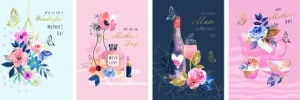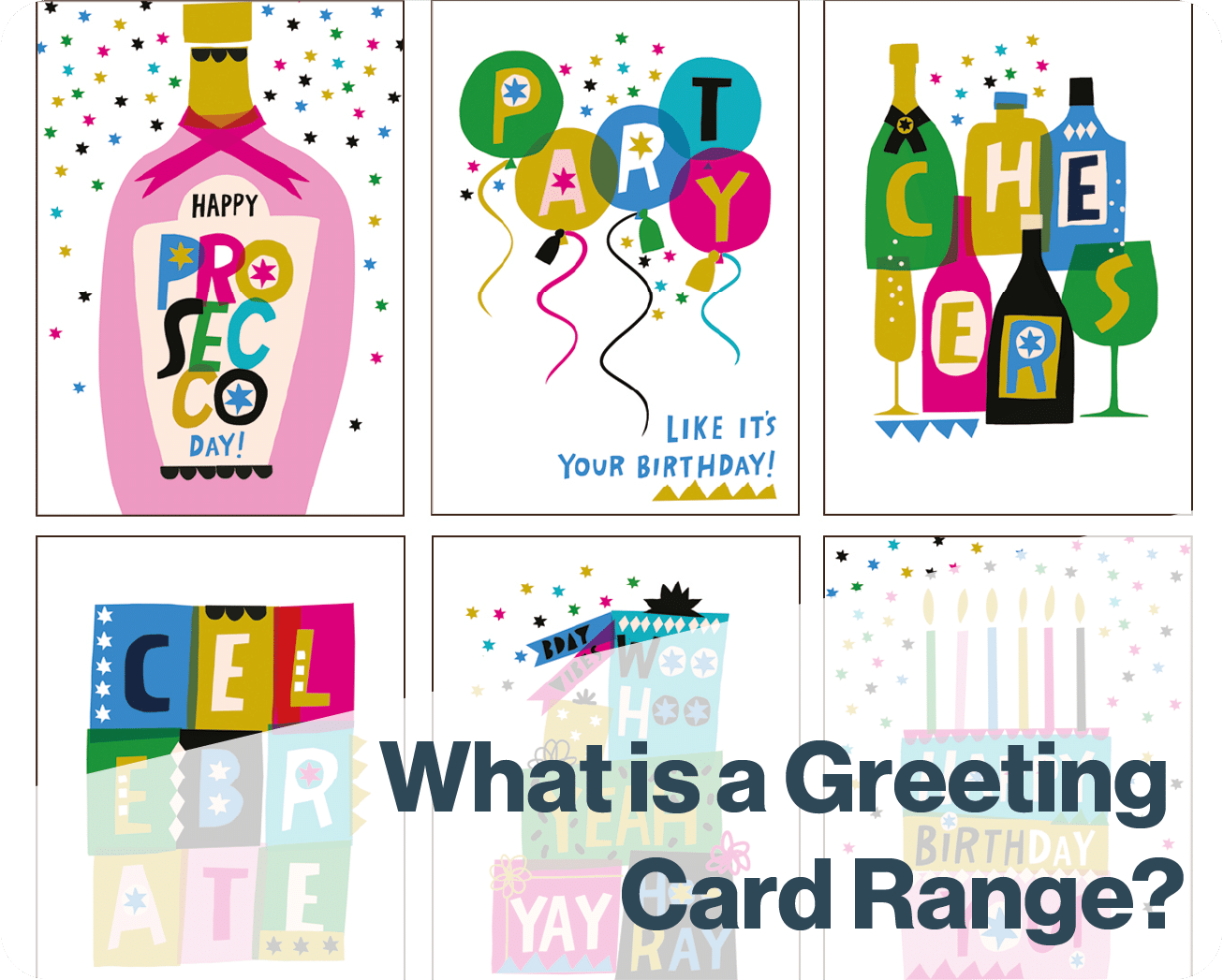What is a Greeting Card Range?
Published on 02/04/2024Greeting Card designs by Advocate Art illustrator Charlotte Pepper
What is a Greeting Card Range?
Teacher: Jo Cave, artist agent at Advocate Art
In the Greeting Card world, we generally plan and create designs in ‘ranges’, which are essentially a collection of designs that are aesthetically linked by style, technique, colour, or theme.
Ranges can start with as little as 4-6 designs, but ideally should be between 8 and 12, although there is no upper limit to the number of designs that can be created with an established look.
For Everyday/Birthday designs, ranges will most likely be displayed together in the retail store, and so it’s really important they have a consistent, impactful appearance that will draw the consumer to them. Captioned cards (designs that are occasion specific such as Mum Birthday, Anniversary, etc.) can still be part of a range, but will be displayed elsewhere in stores. However, it’s still important that they’re linked together in appearance to identify them as part of the same range.
How do I create a range?
Ranges can be linked in the following ways, and the more that apply, the more cohesive your collection will look:
Colour palette – use a consistent colour palette across your designs to link them together. Consider applying coloured backgrounds for maximum impact.
Technique – apply a consistent style or technique across your range, such as the use of collage, photographic elements or line style. This beautiful Mother’s Day range from Di Brookes is linked with a pretty watercolour technique and modern linework for a sophisticated feel.

Type – use a consistent font across your designs, sticking to just one or two typefaces for a cohesive look. Or maybe type can be the overall theme of your range, such as this lettering-based range from Charlotte Pepper.
Theme – you could base your designs around a consistent theme, such as Birthday icons, birds, cocktails, flowers etc etc. This decorative Christmas range from Claire McElfatrick is linked with a food and drink theme with a rich traditional colour palette.
Finishing – it could be the application of a particular finish that unites your designs, such as the use of a coloured foil, embossing etc. Or could you create a range of die-cut cards for maximum impact.
Characters – some of the most successful ranges are those that feature ageless characters, that can then be applied to all sending scenarios.
Why create a range?
Planning your greeting cards as a range from the outset is helpful as it allows you to test the scope of your designs. Does it have the potential to become 10, 20, or even 30 designs across all sends and seasons? If the answer is yes, you could be on to a winner! So try not to think of any design as a one-off, always ask yourself if there is the potential for more!
Think about the most popular and recognisable greeting card characters from past and present, imagine if the creator had stopped at one design?!
More designs means more sales opportunities! If you present a client with a design they love or that has sold really well, and then show them further designs in the same style, they’re likely going to want to snap them up! It’s also really important to consider all relations and occasions when planning your range; if a client liked the look as a Daughter card, they may well want a Sister, Auntie, and Mum card in the same style!
You also need to explore whether the look can translate into other seasons such as Christmas, Mother’s Day, Father’s Day etc. The colour palette may need to be tweaked, but can the technique, finishes, or characters all be transferred?
If you’re struggling to know where to start with planning a range, why not look at designs you’ve already created that were particularly popular or sold well, and use those as a starting point to create 6-8 designs in the same style.
Why stop at cards?! Once you’ve established a cohesive look across your range of greeting cards, why not experiment with how this could be applied to gift wrap, gift bags, and more! More designs equals more sales opportunities!
It is also worth considering that many of the Greeting Card industry annual awards only consider ranges for their award categories, so if you’ve got your eye on an Oscar of the greeting card world, get planning those ranges!
For more free tips for how to improve your creative design skills subscribe to our ITSme Learning Newsletter!
Other News
What Happens in an ITSme Mentorship? A Week-by-Week Breakdown
Imagine having a guide who not only understands the creative path an individual wants to walk, but also has the knowledge and tools to help them get there – successfully. That’s the core of the ITSme Learning Mentorship. Whether someone is a student, a young professional at the beginning of their career, or an artist…
Announcing Our Very First Picture Book Course!
We are extremely excited to announce our first picture book class and mentorship program, in a collaboration between Caroline Wakeman Literary Agency and multi-talented author-illustrator Sally Anne Garland. Your Picture Book Journey: How to Write and Illustrate Your Own Picture Book is a 12-week course for writers, illustrators, and visual storytellers ready to bring their…
Why Every Illustrator Portfolio Needs a Stand-Out Character (Yes, Even Yours)
When you’re thinking about our favourite stories as a child, we often think about the narrative, the themes, perhaps a particular quote that stood out, but the most memorable elements are always the characters. The reason the characters always stay in our minds is because they are the gateway to the narrative, and all of…
Trend Watch: YA Illustrated Covers
Over the past few years, illustrated covers have become a defining visual language in the Young Adult (YA) and New Adult (NA) book market. And no, this isn’t just a passing trend—it’s a design evolution powered by the viral force of #BookTok, #bookgirlies, and a growing appetite for genre-fluid storytelling. Hear what’s driving the…
Trend Watch: The Graphic Novel Boom
Every week we’ll be featuring a new article over on LinkedIn, in our new trend watch series! Graphic novels are having a moment—and it’s no passing trend. From classrooms to bestseller lists, graphic novels are dominating shelves and reading time across all ages. What was once seen as a niche format with a distinct, heavy-lined “comic book”…
Bologna 2025: A Week of Connection
By: Vicky Patoulioti, Talent Source Manager, ITSme This year’s Bologna Children’s Book Fair was one to remember. From early mornings to late evenings, our team Vicky, Bhavi, Ed, and Emily — were on the ground offering free portfolio reviews to artists from all over the world. Mornings kicked off with pre-scheduled reviews, while in the…




